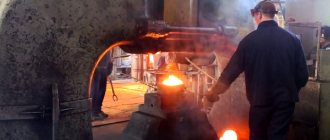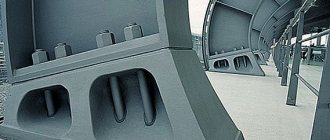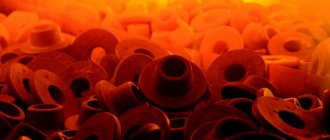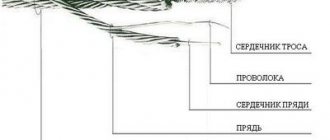Types and grades of steel
Steel is an alloy of iron and carbon with other elements, the carbon content in it is no more than 2.14%.
The most general characteristic is that steel is classified according to its chemical composition:
- carbon steel (Fe – iron, C – carbon, Mn – manganese, Si – silicon, S – sulfur, P – phosphorus). Based on carbon content, it is divided into low-carbon, medium-carbon and high-carbon. Carbon steel is designed for statically loaded tools.
- alloy steel - alloying elements are added: nitrogen, boron, aluminum, carbon, phosphorus, cobalt, silicon, vanadium, copper, molybdenum, manganese, titanium, zirconium, chromium, tungsten, nickel, niobium.
According to the production method and impurity content, steel differs:
- ordinary quality steel (carbon less than 0.6%) – corresponds to GOST 14637, GOST 380-94. St0, St1, St2, St3, St4, St5, St6. The letters “St” indicate ordinary quality steel, the numbers indicate the marking number depending on the mechanical properties. It is the cheapest steel, but inferior in other qualities.
- high-quality steel (carbon or alloy) - GOST 1577, carbon content is indicated in hundredths of % - 08, 10, 25, 40, the degree of deoxidation and the nature of solidification can additionally be indicated. High-quality carbon steel has high ductility and increased weldability.
Low-carbon high-quality structural steels are characterized by low strength and high ductility. Parts for cold stamping are made from sheet steel 08, 10, 08kp. Bolts, screws, nuts, axles, hooks, studs and other parts for non-essential purposes are made from steels 15 and 20.
Medium-carbon quality steels (st. 30, 35, 40, 45, 50, 55) are used after normalization and surface hardening for the manufacture of parts that have high strength and core toughness (axles, screws, bushings, etc.)
Steel 60 - steel 85 have high strength, wear resistance, and elastic properties. Crane wheels, rolling rolls, compressor valves, springs, leaf springs, etc. are made from them.
- high quality - complex chemical composition with low phosphorus and sulfur content - according to GOST 19281.
Steel is also divided by application:
- construction steel - carbon steel of ordinary quality. Has excellent weldability. The number indicates the conditional number of the steel composition according to GOST. The higher the reference number, the higher the carbon content, the higher the strength of the steel and the lower the ductility.
- structural steel - GOST 1050
Carbon-based high-quality structural steels are used in mechanical engineering, for welded, bolted structures, for roofing work, for the manufacture of rails, railway wheels, shafts, gears and other parts of forklifts. The numbers in the marking indicate the carbon content in tenths of a percent.
Structural alloy steels are used for tractor tracks, the manufacture of springs, leaf springs, axles, shafts, automobile parts, turbine parts, etc.
- tool steel - used for cutting tools, high-speed steel for cold and hot deformation of materials, for measuring instruments, for the production of hammers, chisels, chisels, cutters, drills, files, razors, rasps.
- alloy steel is a universal steel containing a special impurity. Silicon content more than 0.5%, manganese more than 1%. GOST 19281-89. If the content of the alloying element exceeds 1 - 1.5%, then it is indicated by a number after the corresponding letter.
- low-alloy steel - where alloying elements are up to 2.5% (09G2S, 10HSND, 18KhGT). Low-alloy steel can be used in conditions of the far north, from -70 degrees C. Low-alloy steel is distinguished by greater strength due to a higher yield strength, which is important for critical structures.
- medium alloyed (2.5 -10%),
- highly alloyed (from 10 to 50%)
- special purpose steel - steel with special physical properties. It is used in the electrical industry and precision shipbuilding.
The weldability of steel is affected by the degree of its deoxidation. According to the degree of deoxidation, steel is classified:
- mild steel (st3sp) - completely deoxidized with a minimum content of slag and non-metallic impurities,
- semi-quiet steel (st3ps) - quality characteristics are similar to calm steel,
- boiling steel (08kp) - unoxidized steel with a high content of non-metallic impurities.
Depending on the standardized characteristics, steel is divided into categories: 1, 2, 3, 4, 5. Categories indicate chemical composition, tensile mechanical properties, impact strength).
Marking features
Marking of carbon steels, the rules for compiling which are regulated by GOST, makes it possible to understand the category and chemical composition of the alloy. Carbon steel of ordinary quality is marked with the letters “ST”. GOST clauses stipulate seven conventional numbers of grades of such steels (from 0 to 6), which are also indicated in their designation. The degree of deoxidation can be found out thanks to the letters “kp” (boiling), “ps” (semi-calm), “sp” (calm), which are indicated at the very end of the marking.
Color marking is applied at the request of the consumer with indelible paint
Carbon steel grades according to GOST and ISO international standards
Grades of high-quality and high-quality carbon steels are simply designated by numbers indicating the carbon content in the alloy in hundredths of a percent. At the end of the designation of some brands you can find the letter “A”. This means that carbon steel has improved metallurgical properties.
You can tell that this is tool steel by the letter “U” at the very beginning of its marking. The number following such a letter indicates the carbon content, but in tenths of a percent. The letter “A”, if it appears in the designation of tool steel, indicates that this alloy has improved quality characteristics.
What are carbon steels?
Carbon steels, which, depending on the main scope of application, are divided into structural and instrumental, practically do not contain alloying additives. These steels are also distinguished from conventional steel alloys by the fact that their composition contains a significantly smaller amount of such basic impurities as manganese, magnesium and silicon.
The content of the main element - carbon - in steels of this category can vary within fairly wide limits. Thus, high-carbon steel contains 0.6–2% carbon, medium-carbon steel – 0.3–0.6%, low-carbon steel – up to 0.25%. This element determines not only the properties of carbon steels, but also their structure. Thus, the internal structure of steel alloys containing less than 0.8% carbon consists predominantly of ferrite and pearlite; with increasing carbon concentration, secondary cementite begins to form.
Carbon steels with a predominant ferritic structure are characterized by high ductility and low strength. If cementite predominates in the steel structure, then it is characterized by high strength, but at the same time it is also very brittle. When the amount of carbon increases to 0.8–1%, the strength characteristics and hardness of carbon steel increase, but its ductility and toughness significantly deteriorate.
The quantitative carbon content also has a serious impact on the technological characteristics of the metal, in particular on its weldability, ease of processing by pressure and cutting. Low-carbon steels are used to make parts and structures that will not be subject to significant loads during operation. The characteristics of medium-carbon steels make them the main structural material used in the production of structures and parts for the needs of general and transport engineering. Due to their characteristics, high-carbon steel alloys are optimally suited for the manufacture of parts that are subject to increased wear resistance requirements, for the production of impact punches and measuring tools.
Carbon steel, like any other category of steel alloy, contains various impurities: silicon, manganese, phosphorus, sulfur, nitrogen, oxygen and hydrogen. Some of these impurities, such as manganese and silicon, are useful; they are introduced into the steel composition at the stage of its smelting in order to ensure its deoxidation. Sulfur and phosphorus are harmful impurities that impair the quality characteristics of the steel alloy.
Although it is believed that carbon and alloy steels are incompatible, microalloying can be performed to improve their physical, mechanical and technological characteristics. For this purpose, various additives are introduced into carbon steel: boron, titanium, zirconium, rare earth elements. Of course, with the help of such additives it will not be possible to make stainless steel out of carbon steel, but they can significantly improve the properties of the metal.
Compound
Depending on the amount of carbon, carbon and alloy steel are divided. The presence of carbon gives the material strength and hardness, and also reduces viscosity and ductility. Its content in the alloy is up to 2.14%, and the minimum amount of impurities due to the manufacturing process allows the bulk to consist of iron up to 99.5%.
High strength and hardness are what characterize carbon steel.
Impurities that are constantly included in the structure of carbon steel have a small content. Manganese and silicon do not exceed 1%, and sulfur and phosphorus are within 0.1%. An increase in the amount of impurities is characteristic of another type of steel, which is called alloyed.
The lack of technical ability to completely remove impurities from the finished alloy allows the following elements to be included in carbon steel:
The presence of these substances is determined by the steel melting method: converter, open-hearth or other. And carbon is added on purpose. If the amount of impurities is difficult to regulate, then adjusting the level of carbon in the composition of the future alloy affects the properties of the finished product. When the material is filled with carbon up to 2.4%, steel is classified as carbon.
Types of carbon steels by carbon content
Carbon is the main element of carbon steel, and its content in the alloy can vary within a fairly wide range: from 0.25% to 2%.
Low carbon steels with carbon content up to 0.25%
Most low-carbon steel is produced in the form of cold-rolled and annealed strips and sheets. Its properties vary depending on the content of basic chemical elements:
- C up to 0.1%, Mn less than 0.4%. The material has a high ability to hot deformation and cold drawing. Used in the production of wire, very thin sheets, containers and car bodies.
- C from 0.1% to 0.25%. This material is stronger and harder than the one described above, and its ability to deform is lower. Often used for the production of parts with a cemented surface layer.
- C about 0.25%, Mn and Al up to 1.5%. High viscosity material. Suitable for metals intended for forging, stamping, seamless tube and boiler sheet production.
- C about 0.15%, Mn less than 1.2%, Pb up to 0.3% (or without), minimal amount of Si. It is used in mass production on automatic lines of parts that are not designed to withstand severe mechanical and temperature loads.
Medium carbon steels with carbon content from 0.2% to 0.6%
Typically, in medium-carbon steels the manganese content is at the level of 0.6-1.65%. They are suitable for the production of products that will be operated under high loads. Can be forged. Suitable for mechanical engineering.
High carbon steels with carbon content from 0.6% to 2%
With an increase in the amount of carbon to 1%, high-carbon steel becomes stronger and harder, while at the same time the limits of its fluidity and ductility decrease. A further increase in carbon by more than 1% leads to the beginning of the formation of a coarse network of secondary martensite, which reduces the strength of the material.
High carbon steel is characterized by high cost, low ductility and poor weldability. This material has a limited scope of application - it is used for the production of cutting tools and high-strength wire.
Steel forging temperature[edit]
[21]
| Steel type | Maximum forging temperature | Combustion temperature | ||
| (°F) | (°C) | (°F) | (°C) | |
| 1.5% carbon | 1920 | 1049 | 2080 | 1140 |
| 1.1% carbon | 1980 | 1082 | 2140 | 1171 |
| 0.9% carbon | 2050 | 1121 | 2230 | 1221 |
| 0.5% carbon | 2280 | 1249 | 2460 | 1349 |
| 0.2% carbon | 2410 | 1321 | 2680 | 1471 |
| 3.0% nickel steel | 2280 | 1249 | 2500 | 1371 |
| 3.0% nickel-chromium steel | 2280 | 1249 | 2500 | 1371 |
| 5.0% Nickel (Cemented) Steel | 2320 | 1271 | 2640 | 1449 |
| Chrome vanadium steel | 2280 | 1249 | 2460 | 1349 |
| High speed steel | 2370 | 1299 | 2520 | 1385 |
| Stainless steel | 2340 | 1282 | 2520 | 1385 |
| Austenitic chromium-nickel steel | 2370 | 1299 | 2590 | 1420 |
| Silicon manganese spring steel | 2280 | 1249 | 2460 | 1350 |
Types of carbon steel by degree of deoxidation
The degree of deoxidation is another factor influencing the division of carbon steels into types. There are 3 types in total: calm, semi-calm and boiling.
Quiet steels are distinguished by a more uniform internal structure - their dewetting is carried out by adding ferrosilicon, ferromanganese and aluminum to the molten metal. There is practically no ferrous oxide in the composition. The structure is fine-grained due to residual aluminum. The result is high-quality metal, suitable for the manufacture of the most critical parts and structures. However, alloys of this type have a significant drawback - their smelting is quite expensive.
Boiling carbon steels are a cheaper, but also lower quality alternative to calm alloys. When smelting them, a minimum amount of special additives is used, and the deoxidation process in the furnace is not completed, as a result of which dissolved gases are present in the structure of boiling carbon steel, which negatively affect its characteristics.
Semi-quiet steels occupy an intermediate position both in properties and in the degree of deoxidation. Before pouring into the molds, a small amount of deoxidizing agents is added to the composition - thanks to this, the metal hardens practically without boiling, while the process of gas evolution continues in it. As a result, there are fewer gas bubbles in the structure of semi-quiet carbon steel than in boiling steel. Most often, semi-mild carbon steels are used as structural materials.
Production
The metallurgical industry produces metal alloys. The specificity of the process for producing carbon steel is the processing of cast iron billets with the reduction of suspended matter such as sulfur and phosphorus, as well as carbon, to the required concentration. The differences in the oxidation technique by which carbon is removed allows us to distinguish different types of smelting.
Oxygen converter method
The basis of the technique was the Bessemer method, which involves blowing air through liquid cast iron. During this process, carbon is oxidized and removed from the alloy, after which the iron ingots gradually turn into steel. The productivity of this technique is high, but sulfur and phosphorus remained in the metal. In addition, carbon steel is saturated with gases, including nitrogen. This improves strength but reduces ductility, making the steel more prone to aging and high in non-metallic elements.
Given the low quality of steel produced by the Bessemer method, it was no longer used. It was replaced by the oxygen-converter method, the difference of which is the use of pure oxygen, instead of air, when purging liquid cast iron. The use of certain technical conditions during purging significantly reduced the amount of nitrogen and other harmful impurities. As a result, carbon steel produced by the oxygen-converter method is close in quality to alloys melted in open-hearth furnaces.
The technical and economic indicators of the converter method confirm the feasibility of such smelting and make it possible to replace outdated methods of steel production.
Open hearth method
A feature of the method for producing carbon steel is the burning of carbon from cast iron alloys not only with the help of air, but also by adding iron ores and rusty metal products. This process usually takes place inside furnaces, to which heated air and combustible gas are supplied.
The size of such melting baths is very large; they can hold up to 500 tons of molten metal. The temperature in such containers is maintained at 1700 ºC, and carbon burning occurs in several stages. First, due to excess oxygen in flammable gases, and when slag forms above the molten metal, through iron oxides. When they interact, slags of phosphates and silicates are formed, which are subsequently removed and the steel acquires the required quality properties.
Steel melting in open hearth furnaces takes about 7 hours. This allows you to adjust the desired composition of the alloy when adding different ores or scrap. Carbon steel has long been manufactured using this method. Such stoves, in our time, can be found in the countries of the former Soviet Union, as well as in India.
Electrothermal method
It is possible to produce high-quality steel with a minimum content of harmful impurities by melting it in vacuum furnaces of electric arc or induction furnaces. Thanks to the improved properties of electric steel, it is possible to produce heat-resistant and tool alloys. The process of converting raw materials into carbon steel occurs in a vacuum, due to which the quality of the resulting workpieces will be higher than the previously discussed methods.
The cost of such metal processing is more expensive, so this method is used when there is a technological need for a high-quality product. To reduce the cost of the technological process, a special ladle is used, which is heated inside a vacuum container.
Types of carbon steel by type and quality
Carbon steel is produced using various technologies, which leads to their separation according to quality characteristics. There are two types of steel:
- structural;
- instrumental.
Structural carbon steel contains up to 0.65-0.70% carbon (as an exception, structural steel containing 0.85% carbon is also produced). It is quite durable, resists impacts well, and is also well processed.
Structural carbon steels are widely used in industry: they are used for the manufacture of structural elements for mechanical engineering and construction purposes, parts for equipment, fasteners and much more.
It is also divided according to quality into 3 types:
- Ordinary quality – steel of wide application, which is suitable for the production of fasteners, pipes, building structures, sheet metal, etc.
- High quality - used for the manufacture of boilers, locomotive and carriage axles, wire, etc.
- High-quality - suitable for parts that require high ductility and impact resistance, used under high pressure, such as pipes, bolts, screws, gears, etc.
Tool carbon steel has a carbon content of 0.7% and higher. This type of steel is hard and durable, making it suitable for tool making. It is divided into high-quality (sulfur 0.03%, phosphorus 0.035%) and high-quality (sulfur 0.02%, phosphorus 0.03%).
Application of carbon steel
Due to their high strength, good machinability, durability and comparative cheapness, carbon steels have found their use in many sectors of the national economy.
They are especially popular in mechanical engineering, which is due to the ability of the metal to resist active loads, as well as high fatigue limits. Thus, carbon steel acts as the main material for the production of:
- flywheels;
- gears of reducers;
- connecting rod bodies;
- crankshafts;
- plunger pump pistons.
Carbon alloys are used to produce technological equipment for the light woodworking industry. In all these cases, structural carbon steels are used. After carburization, this type of metal is used to create wear-resistant parts, the operation of which will be accompanied by significant dynamic loads.
Based on low and medium carbon steel, the following products are produced:
- corners;
- channels;
- pipes;
- I-beams and other profiles
The initial properties of structural carbon steels must be increased by heat treatment (hardening).
The production of tools for various purposes is based on the use of tool steel alloys that contain 0.65–1.32% carbon:
- hammers, cores, screwdrivers, chisels, forging tools, scythes (grade of tool carbon steel U7 and U7A);
- scissors, chipper knives, hand carpentry tools, frame saws (grade U8, U8A);
- drills, small-diameter cutters, band saws, reamers (grade U10, U10A);
- turning wood cutters, hacksaw blades for metal, files, engraving tools (grade U12, U13).
Tool carbon steels are used for the production of measuring instruments. To obtain a small part with a linear dimensional accuracy of several hundred millimeters, the workpiece must not be heated or deformed as a result of the pressure exerted by the cutting tool.
The use of carbon steels of ordinary quality is in demand in construction; some grades are used in mechanical engineering and shipbuilding.









